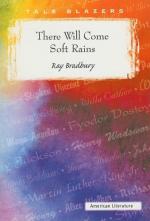
|
| Name: _________________________ | Period: ___________________ |
This test consists of 15 multiple choice questions and 5 short answer questions.
Multiple Choice Questions
1. To what famous dog is this dog an allusion?
(a) Odysseus's dog.
(b) Buck, from Call of the Wild.
(c) Cerberus.
(d) President Lincoln's dog.
2. The use of sentence fragments in the description of the spreading fire is probably intended to create what effect?
(a) Confusion and doubt.
(b) Apathy and resignation.
(c) Chaos and speed.
(d) Distance and irony.
3. The line "And Spring herself, when she woke at dawn," contains an example of which technique?
(a) Oxymoron.
(b) Metaphor.
(c) Personification.
(d) Paradox.
4. Where are the "aluminium roaches and iron crickets"?
(a) In the garage.
(b) In the walls.
(c) In the yard.
(d) In the nursery.
5. What is the likely purpose of inserting the house's "dialogue" ("Help, help! Fire! Run, run!") into the scene that describes the fire consuming the house?
(a) It reminds the reader of the death of the family.
(b) It reminds the reader that the house is a living thing.
(c) It clarifies the order in which the house is burning, because the house can still "speak."
(d) It reinforces how helpless and pointless the technology is in the face of nature's power.
6. To what story do the robot mice allude?
(a) Snow White.
(b) Little Red Riding Hood.
(c) Cinderella.
(d) Beauty and the Beast.
7. What does the dog do once it gets inside the house?
(a) It falls asleep in the nursery.
(b) It looks through the house for the family's other dog.
(c) It barks at every door.
(d) It begins eating the spoiled food.
8. Which is the best summary of how the poem "There Will Come Soft Rains" compares to the short story of the same name?
(a) The poem is a darker version of the same ideas contained in the short story.
(b) The poem is more hopeful about humankind's future.
(c) The poem focuses more on the survival of a world without humans.
(d) The poem focuses more on the role of technology in humankind's demise.
9. When the story ends, what is left standing?
(a) Nothing.
(b) A distant building.
(c) One wall of the house.
(d) A tree.
10. What is the reaction of nature to the end of human existence in the poem "There Will Come Soft Rains"?
(a) Nature is puzzled and uncertain.
(b) Nature celebrates the end of humankind.
(c) Nature grieves the loss of humankind.
(d) Nature is unaware and indifferent.
11. What happens at ten-fifteen?
(a) The house shuts itself down.
(b) The nursery walls come to life.
(c) A window breaks.
(d) The sprinklers begin watering the lawn.
12. On what date does the story begin?
(a) August 4.
(b) August 6.
(c) April 6.
(d) April 4.
13. What does Bradbury compare the chemical fire-fighting foam to?
(a) Seafoam.
(b) Elephants.
(c) Clouds.
(d) Snakes.
14. Why does the dog want to get into the kitchen so badly?
(a) The house has begun making pancakes.
(b) The rest of the house is filling with smoke.
(c) Its food dish is in the kitchen.
(d) It thinks the family is in the kitchen.
15. Who is the author of the poem that the house reads after dinner?
(a) Bradbury.
(b) Teasdale.
(c) Thomas.
(d) Longfellow.
Short Answer Questions
1. Just before the house collapses, what does it do?
2. To what does the phrase "the children's hour" allude?
3. What is strange about how the nursery reacts to the fire?
4. What does the house provide after dinner?
5. Bradbury mentions that martinis "manifested" on tables. What did the martinis do?
|
This section contains 631 words (approx. 3 pages at 300 words per page) |

|




